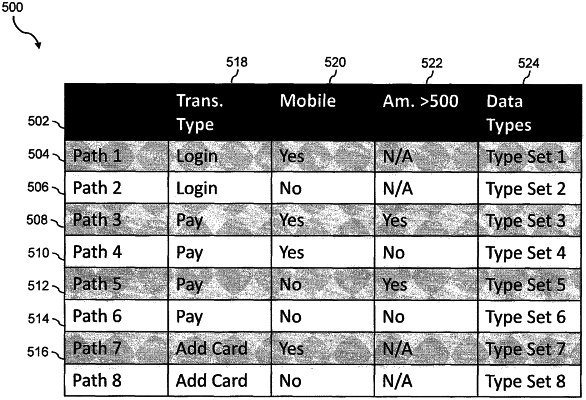| CPC G06N 5/025 (2013.01) [G06Q 20/4016 (2013.01)] | 20 Claims |

|
1. A method for detecting fraudulent transactions by a service provider system, comprising:
accessing, by one or more hardware processors associated with the service provider system, a computer-based transaction processing engine configured to process transaction requests using a transaction rule engine;
receiving, by the one or more hardware processors, a request for processing a transaction from a requesting computing device;
determining processing path exclusion information for the transaction based on an analysis of transaction processing data related to previous processing of a plurality of electronic transactions by the transaction rule engine, wherein the processing path exclusion information comprises one or more excluded data types of a plurality of data types usable for processing the transaction, wherein the processing path exclusion information indicates one or more excluded processing paths, out of a plurality of potential processing paths usable by the transaction rule engine in evaluating electronic transactions, that are determined to be unnecessary for the transaction rule engine to evaluate the transaction,
wherein the service provider system is associated with a data loading configuration table having a data structure that stores the plurality of potential processing paths and specifies one or more data types required under each of the plurality of potential processing paths;
wherein each of the plurality of potential processing paths comprises one or more evaluation nodes, and
wherein each node in each of the plurality of potential processing paths includes one or more computing evaluations;
based on the processing path exclusion information, determining a data loading scheme for the transaction, wherein the data loading scheme specifies a pre-loading of a first group of data items corresponding to a first subset of data types from the plurality of data types and a lazy-loading of a second group of data items corresponding to a second subset of data types from the plurality of data types;
configuring the transaction rule engine to process the transaction based on the data loading scheme;
processing, using the configured transaction rule engine, the transaction, wherein the processing comprises (i) loading the first group of data items, and not the second group of data items, for the transaction, (ii) evaluating the transaction using the loaded first group of data items, (iii) determining that a particular data item from the second group of data items is necessary for the evaluating, (iv) in response to determining that the particular data item is necessary for the evaluating, loading the particular data item, and (v) based on the loaded first group of data items and the loaded particular data item, generating a processing outcome for the transaction; and
transmitting evaluation decision information indicating the processing outcome for the transaction.
|